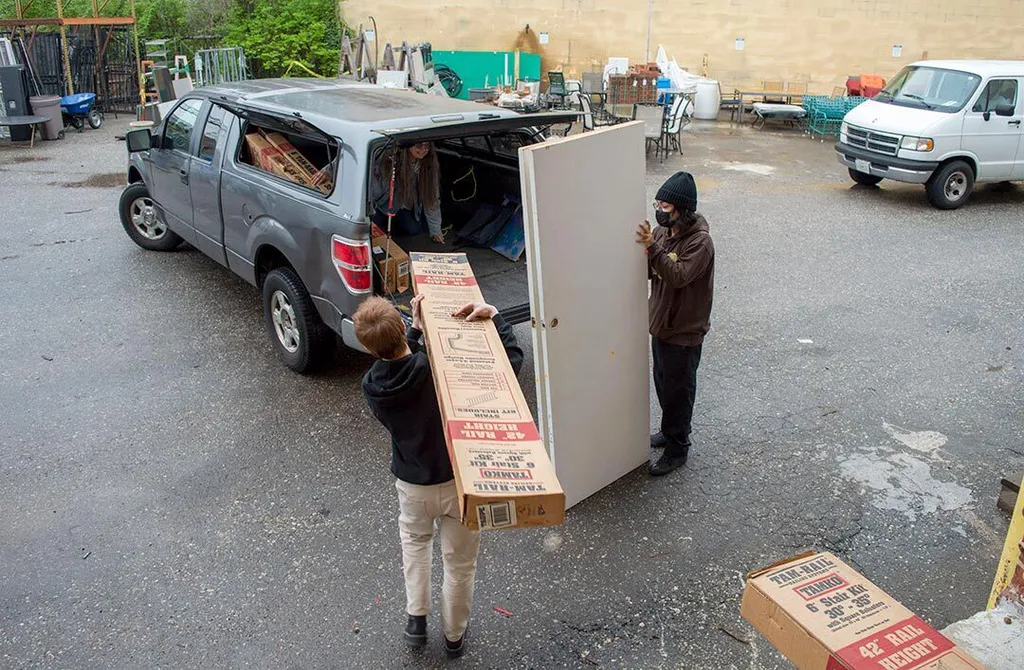- April 16, 2024
- By Sala Levin ’10
Looking for a set of ’70s barstools for a basement renovation or a crystal chandelier for your Victorian’s entry hall? A 40,000-square-foot warehouse in Hyattsville is a secondhand maven’s Disney World, filled with light fixtures, floor-model washing machines, vintage windows and even toilets.
It’s the rare person who’d walk into Community Forklift and think: “Ah, here’s where I’ll find the materials for my next work of art.” But that’s exactly what a new class at the University of Maryland is encouraging students to do.
In “Paint on Site,” Assistant Professor of art Brandon Donahue-Shipp, with support from the nonprofit Community Forklift and the Partnership for Action Learning in Sustainability (PALS), is teaching students to reuse unconventional materials to create works of art. Later this month, the students will unveil their creation on Maryland Day, where the obstacle course they’re working on will be open on Tawes Plaza to any curious passersby.
“The goal is to create a space for tactile, sensory play,” said Donahue-Shipp, whose work is part of the university's Arts for All initiative.

Over the last several weeks, the class has made trips to Community Forklift to comb through its wide-ranging and eclectic collection of home improvement and building supplies. The organization resells donated goods at below market rate at its warehouse located just three miles from campus, while promoting a green message of reusing instead of throwing away.
“What (Donahue-Shipp)’s class is showing is not only can you reuse material for the purposes for which it was originally designed—you can use those in art in a whole variety of ways,” said Kim Fisher, program director at PALS, which partners with cities, counties and state agencies to create classes where students can work with the agencies in their communities.
[A “Second Chance” Organization]
Cydney Walton ’24 and her classmates leaned toward selecting items that the organization had in multiples. “Okay, what are they going to do with 30 of the same chair?” Walton said. “We’re thinking of what [objects] would be best to have a second life, and do it in a way that isn’t then creating more that’s just going to end up back at Community Forklift.”
Later, in an airy studio in the Parren J. Mitchell Art-Sociology Building, a group of students yanked sturdy plastic balusters out of their boxes and laid them out on the floor, poring over the instruction manual to figure out how they fit together into an outdoor deck’s railing to be used in the obstacle course's structure.

In another studio, a different set of students dipped strips of paper in a gluey slurry before draping them over small cardboard boxes that once contained tent stakes, working on the first step of creating an oversized papier-mâché game set, based on the classic children’s game Rivers, Roads and Rails. The empty boxes of tent stakes will eventually have Velcro on one side and a design of three lines on the other side; visitors will affix boxes to a 27-inch base so that each of the lines links up without breaking.
Meanwhile, Yani Debrew ’24 and two classmates bent over an iPad that features a squiggly, brightly colored design; it’s for a cornhole game made from a pair of doors. “We’re designing the door with a Maryland theme—something that’s not just a plain, white door,” she said. “It’s been fun because I have to be creative.”
Fisher hopes that the class will teach students to see how their imaginations can strengthen the environment around them. “It’s always been a goal of mine to show how art can make a difference in our communities, and (Donahue-Shipp)’s class is able to do that.”
